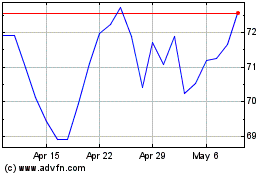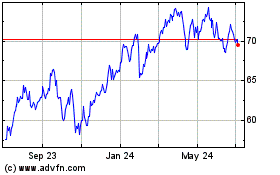New Technology Hubs Offer Strong Growth & Diversification Opportunities, MetLife Investment Management Study Finds
May 23 2017 - 6:30AM
Business Wire
A new study by the real estate division of MetLife Investment
Management entitled “Tech Markets 2.0”, highlights the emergence of
a new generation of technology hubs with positive long-term drivers
that offer real estate investors growth and diversification
opportunities beyond the traditional “core” tech markets.
These “NextTech” markets, including Washington, D.C.;
Pittsburgh; Salt Lake City; and San Diego, provide investors with
the ability to craft focused investment strategies that target real
estate demand driven by specific tech industries.
Often supported by strong university systems, enjoying
substantially lower costs of living, and benefiting from the skill
and experience of transplants from the core tech markets, the
NextTech markets have witnessed a rapid increase in science,
technology, engineering and mathematics (STEM) jobs over the last
three years. These increases are gradually reshaping their local
economies as STEM employment makes up an ever greater share of the
total.
While core tech markets such as Boston and San Francisco still
top the nation in the rate of STEM growth and its role in local
economies, many of the NextTech markets are not far behind.
According to the study, during the three-year period from 2014 to
2016, STEM jobs accounted for 20 percent of the total job growth in
core tech markets, compared to 11 percent in the primary NextTech
markets and 13 percent in the secondary NextTech markets.
Specifically during this three-year period, the study notes that
there were 490,000 new STEM jobs created in the U.S., with more
than two-thirds of them created outside of the core tech markets.
In many of these NextTech markets, STEM job growth accounted for a
significant share of the total, including 44 percent in Pittsburgh,
19 percent in Provo, Utah, and 15 percent in Washington, D.C.
“The NextTech markets are poised to outperform in this cycle and
the next,” said Adam Ruggiero, associate director, MetLife
Investment Management. “The shift towards specializations in these
markets also offers investors the opportunity to place strong bets
on the technologies of the future and the real estate demand their
success will generate. They offer lower concentration risk, strong
starting yields, solid income growth, and rich future
valuations.”
A copy of the study is available upon request.
About MetLife
MetLife, Inc. (NYSE: MET), through its subsidiaries and
affiliates (“MetLife”), is one of the largest life insurance
companies in the world. Founded in 1868, MetLife is a global
provider of life insurance, annuities, employee benefits and asset
management. Serving approximately 100 million customers, MetLife
has operations in nearly 50 countries and holds leading market
positions in the United States, Japan, Latin America, Asia, Europe
and the Middle East. For more information, visit
www.metlife.com.
L0517495339[exp0518][All States]
View source
version on businesswire.com: http://www.businesswire.com/news/home/20170523005190/en/
MetLifeJillian Palash, 212-578-1538
MetLife (NYSE:MET)
Historical Stock Chart
From Mar 2024 to Apr 2024

MetLife (NYSE:MET)
Historical Stock Chart
From Apr 2023 to Apr 2024
